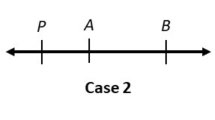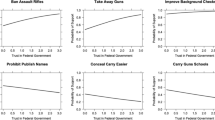Abstract
Previous research has shown that PAC contributions from the National Rifle Association as well as letters and lobbying by Handgun Control, Inc. significantly affected Congressional voting on the Firearms Owners Protection Act of 1986, holding constant ideology, party, constituency characteristics, and a proxy for prior position on the issue. Using data from that study, this paper shows that contributions have a somewhat different effect than lobbying. Contributions from NRA were primarily targeted at NRA supporters and had the net effect of making the progunners even more so. Contributions from Handgun Control, while they did not significantly reinforce the proclivities of the gun controllers, were directed only at that group. At least in this case, money appears to exacerbate conflict. By contrast, the police lobby directed its attention at both gun controllers and pro-gunners; the lobby effectively induced pro-gunners to moderate their position.
These findings are consistent with the hypothesis that PACs associated with membership groups, which seek to retain members whose primary reason for joining is self-expression, are likely to allocate monies in such a way as to exacerbate policy conflict and to allocate lobbying activities so as to induce moderation. Nonetheless, because the gun issue is unidimensional, the finding that money fosters conflict implies only that Congress will be noisy, but not in disequilibrium.
Similar content being viewed by others
References
Brown, K.F. (1983). Campaign contributions and congressional voting. Presented at the 1983 American Political Science Association Meeting, Chicago, IL, 1–4 September.
Carmines, E.G. and Zeller, R.A. (1979).Reliability and validity assessment. Beverly Hills: Sage.
Chappell, H.W., Jr. (1981). Campaign contributions and voting on the cargo preference bill: A comparison of simultaneous models.Public Choice 36: 301–312.
Chappel, H.W., Jr. (1982). Campaign contributions and congressional voting: A simultaneous probit-tobit model.Review of Economics and Statistics (February): 77–83.
Denzau, A.T. and Munger, M.C. (1986). Legislators and interest groups: How unorganized interests get represented.American Political Science Review 80(1): 89–106.
Fenno, R.F., Jr. (1978).Homestyle: House members in their districts. Boston: Little, Brown.
Frendreis, J.P. and Waterman, R.W. (1985). PAC contributions and legislative voting behavior: Senate voting on trucking deregulation.Social Science Quarterly(June): 401–412.
Grenzke, J. (1989). PACs and the congressional supermarket: The currency is complex.American Journal of Political Science 33(February): 1–24.
Hall, R.L. and Wayman, F.W. (1990). Buying time: Moneyed interests and the mobilization of bias in congressional committees.American Political Science Review 84(3): 797–820.
Kalt, J.P. and Zupan, M.A. (1990). The apparent ideological behavior of legislators: Testing for principal-agent slack in political institutions.Journal of Law and Economics 33(April): 103–131.
Kates, D.B., Jr. (1990). Bigotry, symbolism and ideology in the battle over gun control. Presented at the 1990 Annual Meeting of the Law and Society Association, Berkeley, CA.
Kau, J.B. and Rubin, P.H. (1982).Congressmen, constituents, and contributors. Boston: Martinus Nijhoff.
Langbein, L.I. and Lotwis, M.A. (1990). The political efficacy of lobbying and money: Gun control in the U.S. House, 1986.Legislative Studies Quarterly 15(3): 414–440.
McIver, J.P. and Carmines, E.G. (1981).Unidimensional scaling. Beverly Hills: Sage.
Moe, T.M. (1980). A calculus of group membership.American Journal of Political Science 24(4): 593–632.
Richardson, L.E., Jr. and Munger, M.C. (1990). Shirking, representation and congressional behavior: Congressional voting on the 1983 amendments to the Social Security Act.Public Choice 67(1): 11–34.
Riker, W.H. and Ordeshook, P.C. (1973).An introduction to positive political theory. Englewood Cliffs, NJ: Prentice-Hall.
Sabato, L.J. (1984).PAC power. New York: Norton.
Salisbury, R.H. (1984). Interest representation: The dominance of institutions.American Political Science Review 78(1): 64–76.
Saltzman, G.M. (1987). Congressional voting on labor issues: The role of PACs.Industrial and Labor Relations Review 40(2): 163–179.
Schroedel, J.R. (1986). Campaign contributions and legislative outcomes.Western Political Quarterly 34(September): 371–389.
Silberman, J.I. and Durden, G.C. (1976). Determining legislative preferences on the minimum wage: An economic approach.Journal of Political Economy(April): 317–329.
Welch, W.P. (1982). Campaign contributions and legislative voting: Milk money and dairy price supports.Western Political Quarterly(December): 478–495.
Wilhite, A. and Theilmann, J. (1987). Labor PAC contributions and labor legislation: A simultaneous logit approach.Public Choice 53(3): 267–276.
Wittman, D. (1989). Why democracies produce efficient results.Journal of Political Economy 97(6): 1395–1424.
Wright, J.R. (1985). PACs, contributions and roll calls: An organizational perspective.American Political Science Review(June): 400–414.
Wright, J.R. (1990). Contributions, lobbying and committee voting in the U.S. House of Representative.American Political Science Review 84(June): 417–438.
Yin, R.K. (1984).Case study research. Beverly Hills: Sage.
Author information
Authors and Affiliations
Rights and permissions
About this article
Cite this article
Langbein, L.I. PACs, lobbies and political conflict: The case of gun control. Public Choice 77, 551–572 (1993). https://doi.org/10.1007/BF01047860
Accepted:
Issue Date:
DOI: https://doi.org/10.1007/BF01047860




